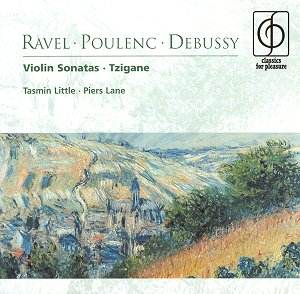Like Johannes Brahms and Frederic Chopin before him,
Maurice Ravel holds the rare distinction of being a composer that left
us with few if any substandard works. It would seem as though the man
were incapable of producing anything save masterpieces. The two works
for violin and piano presented here are shining examples of Ravelís
flawless craftsmanship.
Listening to the violin sonata is akin to being in
a room in which multiple conversations are happening at once. This is
not a dialogue between two musicians rather; it is two separate speeches
that although related in topic, do not mesh exactly. That which is of
interested to his ear at the moment captures the listenerís attention,
and each repeated listening gives the opportunity for a new discovery.
The genuine stroke of genius in the work is the brilliant second movement,
completely idiomatic as both jazz and concert music. The Tzigane is
the offspring of Ravelís intensive study of violin technique via Paganini
and of Hungarian Gypsy melodies as performed for him by violinist Jelly
díArányi.
Perhaps no composer of his generation has a more immediately
recognizable harmonic and rhythmic language than Francis Poulenc. The
violin sonata is Poulencís third attempt at the genre, who admittedly
uncomfortable writing for solo strings, had destroyed two earlier attempts.
Dedicated to Federico Garcia Lorca and the violinist Ginette Neveu,
the work not only reflects the violence of conflict (specifically the
Spanish Civil War) but also the tragedy of loss. When Miss Neveu met
her untimely demise in an air crash in 1949, Poulenc extensively revised
the piece as a reflection of his grief.
Debussyís sonata was the third in what was to be a
set of six sonatas for various instruments. The composer died before
the he was able to finish the projected remaining pieces. The structure
of the three completed works offer a hint that Debussy was moving into
a neo-classical phase. Having avoided the sonata form for most of his
mature career, these works show a harmonic simplicity and close attention
to melody that is absent from his earlier compositions. There is still
present, however, the composerís delight in rich sonority for its own
sake.
Tasmin Little and Piers Lane have given us performances
that are sheer delights. Littleís clean technique and precise intonation
are coupled with the perfect combination of elegance and virtuosity.
Piers Lane is a superb partner, and the mutual respect that these musicians
show for each otherís playing is evident in the manner in which each
player gives, takes and shares the limelight. This is the kind of music
that reminds one of a perfect day, and these players deliver it to us
like a beautifully prepared meal. One leaves the recital with nothing
save satisfaction. Of particular merit is the performance of the Ravel
sonata, which captures splendidly the carefree elegance of Paris in
the roaring twenties. Littleís execution of Ravelís jazz-influenced
effects is dead on. He plays with an ease and spirit that is breath
taking. Both musicians have such an effortless breezy manner, making
the challenging technical hurdles of these pieces seem like childís
play.
EMIís engineers have given us a lively, well-balanced,
natural sounding recording. Philip Borg-Wheelerís notes are concise
and informative, aptly describing the music and avoiding the tedious
blow-by-blow commentary that so bogs down many a booklet essay.
This is a worthy addition to any collection, and one
that is sure to give hours of repeated listening enjoyment.
Kevin Sutton


